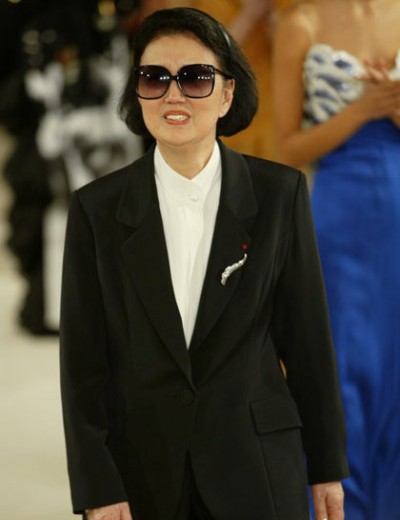
Hanae Mori
About
Born in Tokyo, Japan in 1926. She studied at Tokyo Christian University and left, but returned some years later to study fashion design. This was after she had married Kei Mori and had two sons named Aki and Kei.
She began dressmaking for the Japanese film industry. She opened her first shop in Tokyo in 1951. In 1955 she moved to the Ginza, the smart shopping area of Tokyo. Over the next decade, she designed costumes for hundreds of Japanese movies, including Ozu's "Early Autumn."
In 1960, during a visit to Paris, she went to the salon of Coco Chanel to get fitted for a suit. She had the opportunity to chat with the great designer. She afterwards said that this moment changed her life, because from then on her dream was to design haute couture clothes.
The Look
A delicate sense of feminine beauty, stemming from Hanae Mori's Japanese heritage, is married to an artistic use of color and fabric in all her work. She treads a careful line, balancing Eastern influences with Western ideals to produce consistently successful couture and ready-to-wear lines with international customers. If her clothes lack the more outrageous, attention-grabbing qualities of some of her couture counterparts, they compensate with the economy of their cut and base their appeal on the practical needs of the wealthy metropolitan women who wear them. By stepping outside current trends and concentrating on conservative but always feminine daywear, Mori has established a niche for herself in the Parisian fashion arena. Integral to this is the sense of the longevity of her easy-to-wear separates, which even in the ready-to-wear line retain a delicacy of touch through the textiles used. Mori elaborates on the basic tenets of combining fine fabrics and flattering cut, adding her own feel for the dramatic to her eye-catching eveningwear. For this she makes optimum use of the lustrous printed textiles produced by her husband until his death in 1996. Although there is an air of restrained elegance to much of her design, symbolized by the fragile butterfly motif by which she is known, her eveningwear often breaks into more vibrant realms. In 1981 Mori produced a languorous silk mousseline dress, the vampish leopard print and deep décolleté of which were balanced by the soft, sinuous fall of the fabric. Other examples used bright hot colors, juxtaposed in one ensemble to provide interest, bringing a strong Japanese feel to their narrow hues, frequently harking back to the kimono for their silhouette and cut. It is in this area that her work is most inspired, bringing together European tailoring and Japanese color and ideals of beauty. She uses the Japanese love of asymmetry to further develop her style and the linear patterns she prints onto her distinctive silks. She exploits the natural appeal of such fabrics with a well-defined sense of cut to illuminate her realistic styles. By doing so, Mori is providing both an alternative to and a definite rejection of the type of elaborate couture confections that mold the female form into fantastical shapes, ignoring the woman beneath the fabric. The other main strand to Mori's design is her close involvement in the arts. Her early costuming of innumerable Japanese films enabled her sense of color to evolve, using each primary-hued textile to represent a different emotion, and sharpened her sense of the dramatic effect of dress. This has grown in her work for opera and ballet, the clothing full of delicacy and poise counterpointed with strong coloration, the arresting mixes representing the two worlds her design principles straddle.
Who Wears It
Princess Grace of Monaco and Crown Princess Masako of Japan